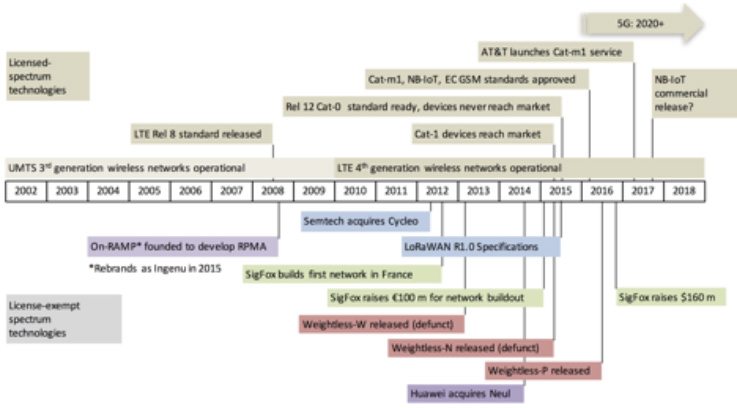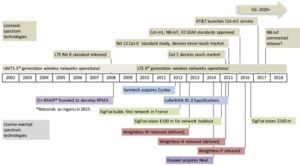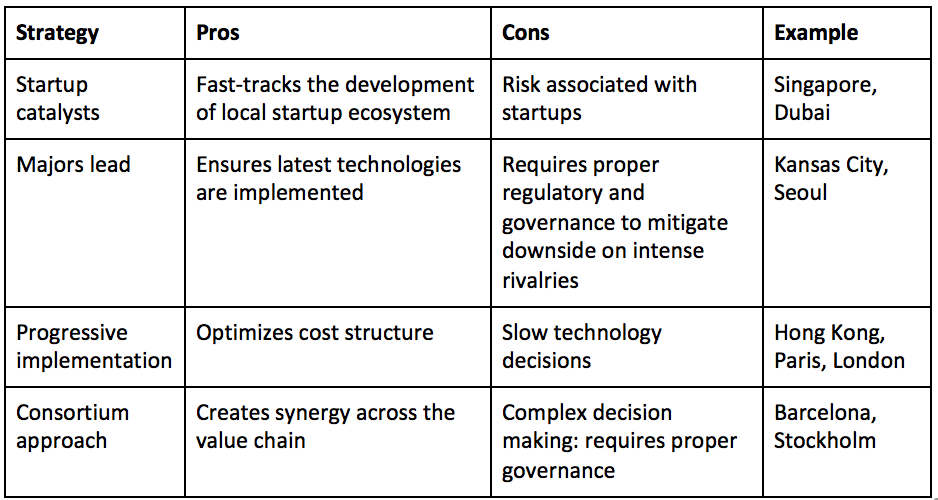Based on the hands-on involvement of the Xona Partners team in the design and rollout of smart cities, we found a clear lag in the deployment of technologies and services versus what technologies enable. We call this the cascading technology trap: technologies are evolving at a significantly faster pace than the ability of cities to adopt. This is not to diminish the importance of the other challenges facing smart cities, such as financing deployments or managing organizational structures in a way that is consistent with governance models. However, for cities determined on implementing smart city applications, the cascading technology trap proved to be one of the most complex challenges to overcome.
Anatomy of the cascading technology trap
Cities are determined to exploit technology to improve operational efficiency and the life of citizens, yet technology development was at the forefront of challenges facing these cities. Technologies are coming on the market at a fast rate that is challenging even for technology ecosystem players themselves to decide on which technology to back. This challenge can only be amplified for cities. The proliferation and fragmentation of technologies each with different go-to-market strategy presents a complex mix of choices for cities to choose from. As an example of rapid technology evolution, consider the myriad of technologies available for the Internet of Things connectivity applications: a new protocol comes to market in under two years!
The leading Internet and cloud companies, like Google and Amazon, who are driving innovation in information technology follow a different model of developing and deploying technologies that make it difficult for the rest of the industry to absorb and adopt. Smart city organizations experience an even more exasperated challenge in doing so as the rapid evolution of Information Technology exceeds their ability to assimilate knowledge, make decisions, plan, design and deploy a particular technology at scale. This results in strong competition between multiple technology camps and little stability.


Internet of Things connectivity protocols
Leaps in technology are not only moving at a rapid pace, but they are also increasing in complexity requiring very sophisticated skills that come at high cost. In fact, commercial entities have been battling to acquire those rare skillsets, making it harder for government organizations of smart cities to achieve the same. The reliance on modern technologies on virtualized environment accentuates the need for skills in software that many cities either don’t possess or find hard to attract.
Cities plan over the long term and expectation for mature technologies and validated business case. Modern technologies have a short lifespan relative to what cities seek. Often, the business case is not validated for wide-scale deployment. Validating the return on investment is a time-consuming activity. Moreover, the organizational structure of cities, the decision-making cycle, the process of evaluation and deployment is slow to assimilate complex modern technologies that cut across vertical silos around which city functions have developed.
Avoiding the cascading technology trap
How can cities address the cascading technology trap? Leading cities adopted different strategies. While we summarize a few such strategies, we are convinced that solutions have to be tailored to the specific city. Such solutions would consider size, location, governance structure, economic conditions, state of infrastructure, among other factors. The leading strategies include:
1- Startups involvement: develop engagement models that allow startups and innovative companies to participate in smart city solutions. This includes defining a startup-friendly deal-flow and procurement process and encouraging compatibility of startup solutions with those from larger solution providers.
2- Global view: Bridge from a local perspective into a global perspective by optimizing the learnings from other cities, primarily those related to technical solutions. There are multiple approaches to achieve this objective, with one of the most relevant being establishing a task force to review and analyze results of select technology deployments in global cities.
3- Link to leading technology players: Bridge into globally leading technology players that have a fair control over technologies central to smart cities. Primary approaches include providing incentives to global players to dedicate resources to smart cities experimentation models and enacting favorable regulations for such players, for example, related to wireless frequencies, data privacy, drones, etc.
4- High-end talent: to bridge the divide between new technologies and their implementation timelines is key ultimately requires building capable technology teams. This could be achieved as a federated exercise across cities where the pool of resources is shared along with returns.

No one strategy to avoid the cascading technology trap is perfect. Cities have much in common but also differ in important aspects that necessitate tailored models. But a common thread in all the models emerges: the integration of specialized technology experts within smart city organizations is critical.
Conclusion
The evolution towards smart cities has been synonymous with leveraging new information and data management solutions to optimize operations and offer essential services to citizens. Such solutions are evolving rapidly with successive technologies coming onto the market faster than cities, and even technology companies, can absorb and leverage. This cascading technology trap is at the forefront of challenges for cities determined to implement their progressive vision of smart city solutions. In response, leading cities developed different models to address this challenge. These models remain evolving. While no single model is best, successful cities integrate highly specialized technology personnel within the smart city framework.
Xona Partners is a boutique advisory firm specialized in technology businesses incubation & growth strategies

